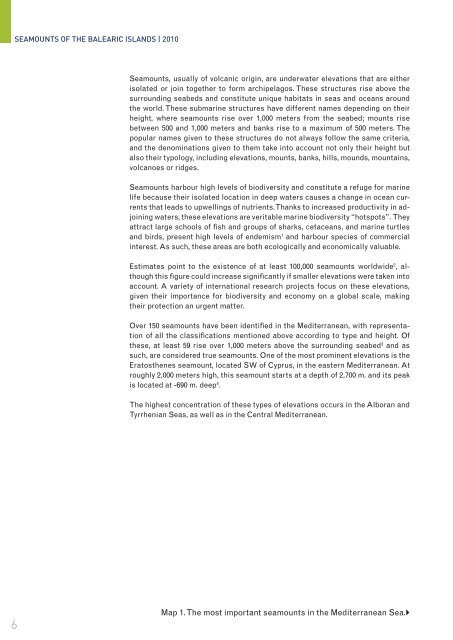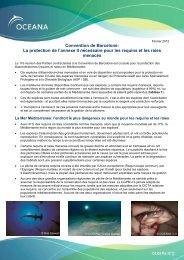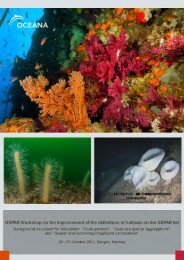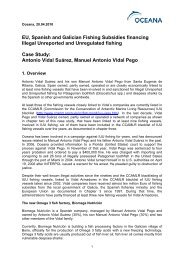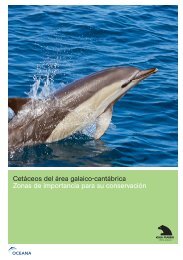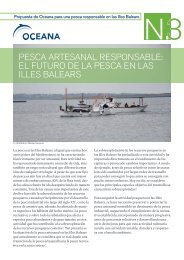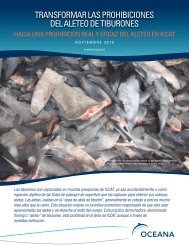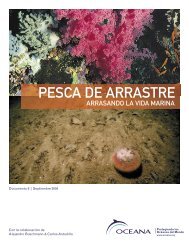Download "Seamounts of the Balearic Islands | 2010" - Oceana
Download "Seamounts of the Balearic Islands | 2010" - Oceana
Download "Seamounts of the Balearic Islands | 2010" - Oceana
Create successful ePaper yourself
Turn your PDF publications into a flip-book with our unique Google optimized e-Paper software.
6<br />
SEAMOUNTS OF THE BALEARIC ISLANDS | 2010<br />
<strong>Seamounts</strong>, usually <strong>of</strong> volcanic origin, are underwater elevations that are ei<strong>the</strong>r<br />
isolated or join toge<strong>the</strong>r to form archipelagos. These structures rise above <strong>the</strong><br />
surrounding seabeds and constitute unique habitats in seas and oceans around<br />
<strong>the</strong> world. These submarine structures have different names depending on <strong>the</strong>ir<br />
height, where seamounts rise over 1,000 meters from <strong>the</strong> seabed; mounts rise<br />
between 500 and 1,000 meters and banks rise to a maximum <strong>of</strong> 500 meters. The<br />
popular names given to <strong>the</strong>se structures do not always follow <strong>the</strong> same criteria,<br />
and <strong>the</strong> denominations given to <strong>the</strong>m take into account not only <strong>the</strong>ir height but<br />
also <strong>the</strong>ir typology, including elevations, mounts, banks, hills, mounds, mountains,<br />
volcanoes or ridges.<br />
<strong>Seamounts</strong> harbour high levels <strong>of</strong> biodiversity and constitute a refuge for marine<br />
life because <strong>the</strong>ir isolated location in deep waters causes a change in ocean currents<br />
that leads to upwellings <strong>of</strong> nutrients. Thanks to increased productivity in adjoining<br />
waters, <strong>the</strong>se elevations are veritable marine biodiversity “hotspots”. They<br />
attract large schools <strong>of</strong> fish and groups <strong>of</strong> sharks, cetaceans, and marine turtles<br />
and birds, present high levels <strong>of</strong> endemism 1 and harbour species <strong>of</strong> commercial<br />
interest. As such, <strong>the</strong>se areas are both ecologically and economically valuable.<br />
Estimates point to <strong>the</strong> existence <strong>of</strong> at least 100,000 seamounts worldwide 2 , although<br />
this figure could increase significantly if smaller elevations were taken into<br />
account. A variety <strong>of</strong> international research projects focus on <strong>the</strong>se elevations,<br />
given <strong>the</strong>ir importance for biodiversity and economy on a global scale, making<br />
<strong>the</strong>ir protection an urgent matter.<br />
Over 150 seamounts have been identified in <strong>the</strong> Mediterranean, with representation<br />
<strong>of</strong> all <strong>the</strong> classifications mentioned above according to type and height. Of<br />
<strong>the</strong>se, at least 59 rise over 1,000 meters above <strong>the</strong> surrounding seabed 3 and as<br />
such, are considered true seamounts. One <strong>of</strong> <strong>the</strong> most prominent elevations is <strong>the</strong><br />
Eratos<strong>the</strong>nes seamount, located SW <strong>of</strong> Cyprus, in <strong>the</strong> eastern Mediterranean. At<br />
roughly 2,000 meters high, this seamount starts at a depth <strong>of</strong> 2,700 m. and its peak<br />
is located at -690 m. deep 4 .<br />
The highest concentration <strong>of</strong> <strong>the</strong>se types <strong>of</strong> elevations occurs in <strong>the</strong> Alboran and<br />
Tyrrhenian Seas, as well as in <strong>the</strong> Central Mediterranean.<br />
Map 1. The most important seamounts in <strong>the</strong> Mediterranean Sea.►


